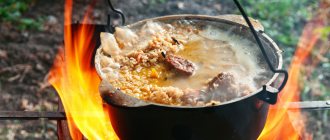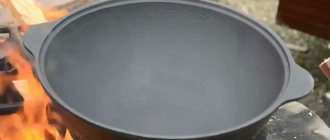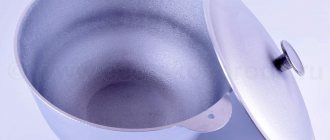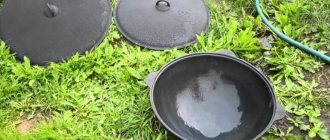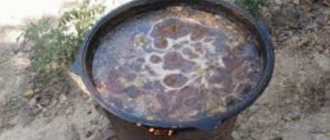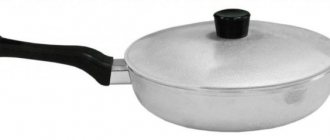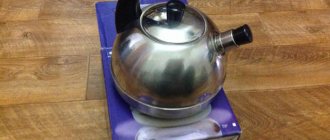Which cauldron is better, aluminum or?
In general, an aluminum cauldron is an affordable and easy-to-use option. ... Which cauldron is better: cast iron or aluminum
| Properties | Cast iron cauldron | Aluminum cauldron |
| Cooking speed | long languor | quick cooking |
| Recommended Use | at the stake | on the stove |
| Warm-up speed | takes a long time to warm up | heats up quickly |
| Weight | heavy | easy |
Interesting materials:
How to get Staly Pobyt? How can a Ukrainian obtain refugee status in Russia? How to obtain refugee status in Germany 2022? How to obtain refugee status in Germany? How to obtain refugee status in Italy? How to obtain refugee status in Israel? How to obtain refugee status in Poland? How to obtain refugee status in Russia? How to obtain refugee status in the USA? How to obtain refugee status in the UK?
Why fire a new cauldron?
Utensils leave the factory assembly line in salable condition, but you cannot cook food in them. Cauldrons are made by casting; the molds are lubricated with a special mixture so that the hot metal does not stick. Before shipping, the dishes are processed again and covered with a protective layer that protects cast iron and porous duralumin from corrosion damage.
Proper preparation of dishes for use and their processing will help to avoid many problems with them in the future.
The lubricant is not food grade, so you need to get rid of it after purchase. This cannot be done with soap, a brush and hot water. Porous metal deeply absorbs coating components.
Important! Do not wash porous castings with aggressive detergents. The chemical will sit deep in the pores and will be released during the cooking process. The food will turn out tasteless.
What you need to know first
Unpleasant smoke, smell and taste in the cauldron is formed if the preparation of the cauldron for the first use was not carried out or something was done wrong. All foreign odors when working with a cauldron appear due to the fact that this type of kitchen equipment is generously coated with machine oil during manufacture. Or rather, it is not the cauldron itself that is lubricated, but the mold in which it is cast. This is done so that the future cauldron does not stick to the mold. Therefore, there is no way to do without primary processing after purchase. It is absolutely necessary to ensure that all remaining oil is removed. After which the cauldron must be heated, otherwise, at the end of cooking, its surface will be covered with rust, and the food will burn.
How to choose
Cooking in cast iron cookware has some nuances, so beginners and those who don’t like extra hassle should turn their attention to aluminum. An aluminum cauldron is perfect for an electric stove, but you can also cook in it on gas.
When choosing a suitable cauldron, you should decide on its shape. Most often, standard products are offered in the shape of a hemisphere. However, there are some peculiarities here. Undoubtedly, if the house has a special stand, or a cauldron is needed for cooking over a fire, this option will be ideal. Food mixes easily and does not remain in the corners.
If we are talking, for example, about a gas stove, difficulties may arise here. In such a situation, you should pay attention to models with a flat bottom. The inside of the cauldron will also be rounded, which will not interfere with the preparation of your favorite dishes.
Next you need to decide on the volume. If you plan to cook food on the stove, you should take a cauldron no more than 8 liters. This size will be enough to feed pilaf to 10 to 12 people. Products with a volume of over 8 liters may have problems with uniform heating, so it is recommended to use them in other cases, for example, when cooking on a grill or fire, since the heating zone can be increased.
The simplest aluminum products presented on store shelves have a fairly affordable price. However, for cooking pilaf it is better to choose a thick-walled cauldron. In addition, models with non-stick coating have reliably come into fashion. It is known to prevent food from burning. In addition, such products are very easy to clean; just boil water in them.
Other rules of care
After cooking in an aluminum cauldron, it should be thoroughly cleaned. In this case, prolonged soaking is excluded, especially with the use of detergent compositions. The best option would be to simply rinse in clean water and wipe with a sponge.
To ensure that the cauldron lasts as long as possible, after washing it, you can carry out the following procedure. The product is filled almost to the brim with water, boiled, wiped, after which a small layer of oil is again applied to it. Next, the cauldron can be sent for storage. Housewives need to take into account that remaining food particles stick to the walls very quickly. If this does happen, the cauldron will have to be soaked. This should be done in clean warm water.
Using oil for calcination
After completely burning out the harmful oil, another film of oil needs to be formed on the walls of the new cauldron. Only vegetable oil is already used.
The volume of your cauldron matters here. Usually a minimum of 500 – 1000 ml of oil is required to cleanse. It is poured into a cauldron. It is placed on low heat for 30 minutes. During such boiling, the cauldron must be periodically tilted so that its walls are completely covered with the required film.
Then the stove turns off. The oil is cooling. It is drained from the cauldron. The cauldron itself should be cleaned with warm water. Detergents must not be used. The dishes are wiped dry. You need to walk along its internal surfaces with a rag previously soaked in natural oil. Your new aluminum cauldron is now ready for use. Please note that if not handled properly, the oil may ignite.
Caring for an aluminum cauldron is quite troublesome than preparing it for use. Its protective film can be easily removed due to harsh cleaning devices: washcloths and brushes.
And if you want to purchase an aluminum product that will largely replace the thick-walled cast iron Tatar analogue, the walls of this product must be at least 1 cm thick.
Restoring the non-stick layer after cleaning the cauldron
Treatment will allow you to return the usual properties of the dishes. After thorough cleaning, it will lose its characteristics and food will stick and burn. The usual color is lost.
Tips for restoring the non-stick layer
Washing with warm water, wiping dry, coating with salt and baking will help restore properties. If this has already been done, all that remains is to apply sunflower oil to the inside.
Why calcinate a cast iron cauldron?
Calcining the cauldron is a mandatory action after purchasing it. This is due to the peculiarities of the production of such dishes. The fact is that the process of manufacturing products consists of casting and pressing in a special unit. As a result, machine oil and corrosion protection agents get into the surface structure, which must be removed. If this is not done, the food will burn and become saturated with the taste and smell of machine oil.
Where can you prepare a cauldron for first use?
There are many places where cast metal can be calcined.
Cast iron is heated:
- in the garage or in the yard using a blowtorch;
- on a fire, made in nature;
- barbecue, you will have to constantly throw coals
- Russian stove;
- home stove (gas or electric);
- in the oven.
Kitchen utensils must first be washed with warm water and any detergent and then burned.
Each owner of the dishes chooses a place to prepare the cauldron at his own discretion.
At the stake
The fire is lit low. To install the cauldron, make a stand of stones or bricks. If you have a barbecue at your dacha, you can use it.
The main thing is that the dishes stand level and secure.
At home
The cauldron is placed on the stove burner or, if the utensil is not very large, placed in the oven. You need to be prepared for the fact that all kitchen textiles will have to be washed; they will smell strongly of burning. It's better to remove it right away:
- indoor flowers;
- upholstered furniture (corner);
- curtains;
- napkins;
- extra towels,
- aprons;
- decor made from natural materials;
- textile potholders.
At home, it is better not to burn the cauldron, but if there is no other way, then you need to ensure a constant flow of air in the room.
You need to leave only the essentials.
The door to the kitchen should close tightly and there should be good ventilation. It will take a couple of hours to heat the utensils, no less.
It is important to open all windows wide open and turn on the hood.
Note! If there is no exhaust ventilation in the kitchen, you should not engage in firing in the apartment. A persistent smell will fill the entire apartment and will last for a week.
Existing firing techniques
Let us immediately note that the process of preparing for further operation is quite simple. It involves treatment with fire so that the factory grease disappears from the dishes, and subsequent rinsing with warm water.
Those who are interested in how to heat a new cast iron cauldron should understand that metal scourers and detergents cannot be used during the pre-treatment process. Today there are two methods of firing such products:
- Over an open fire using an outdoor oven or barbecue.
- On a gas stove or in the oven.
It should be understood that the calcination process is accompanied by the release of a large amount of smoke and fumes resulting from burning of the oil. Therefore, if the procedure is carried out indoors, it is necessary to turn on the hood in advance, as well as open doors and windows to provide a draft.
Proper processing after calcination
Preparation of any cast cookware for cooking ends after the formation of a shiny film on the inner surface, which acts as a non-stick coating.
It tightly seals the pores in the metal and protects against moisture.
The process of oil preparation of a cauldron for first use:
- Dry utensils are generously lubricated with oil from the inside. External stains are removed with a cloth or paper napkins.
- Place the greased dishes in the oven or on the fire.
- Wait for the oil to start smoking.
- Transfer the casting to a stand and allow to cool slightly.
- Remove carbon deposits with paper or textiles.
- They lubricate the walls again and set them to burn.
The procedure is carried out up to 5 times.
After this, the metal cannot be washed with detergents; just pour boiling water over it and wipe it.
Rules for firing a cauldron before first cooking
Food casting is fired so that the factory lubricant burns out. It turns into smoke and soot, which is removed with hot water and soap. The procedure for firing a cast-iron cauldron before the first cooking is lengthy and unpleasant: a fair amount of smoke is generated, and it does not smell like roses. Aluminum is processed faster; when working with it, several nuances must be taken into account. There are features of firing a cauldron.
The food turns out much tastier and more aromatic, since such dishes are cleaned of technical grease and undergo a procedure for renewing the protective coating with oil.
Note! Some manufacturers produce cauldrons with a black non-stick coating. This is a thin layer of durable enamel. It is not oily to the touch; when wiping new dishes, no stains remain on the napkin. If you pour water, rainbow stains will not appear on it.
Cast iron
Cast iron products are very heavy. Casting is done with thick walls, thanks to which the products simmer rather than boil or fry. Cast iron must be handled with care. If accidentally dropped, the metal may crack; the alloy is classified as brittle. Below is detailed instructions on how to fire a new cast iron cauldron over a fire and at home, what you will need for this.
Without proper processing, food cooked in a cauldron will simply be inedible and smell bad, and cooking in general will become impossible.
Note! Cast iron is not afraid of temperature contrasts. Previously, cast iron pots were fired in winter, thrown out of the fire into the snow, then wiped dry and put back on the fire. The procedure was repeated several times.
Aluminum
Aluminum alloy, or rather duralumin for casting, is valued for its low specific gravity. But the metal has one peculiarity: when unevenly heated, internal stresses form in it; the cauldron can become deformed if fired over high heat.
If you want to maintain the roundness of the walls and the evenness of the bottom, the metal should be heated slowly, gradually.
By the way, the thermal conductivity of aluminum is higher than that of cast iron. Food in an aluminum cauldron cools down faster and is not as flavorful.
Aluminum casting is often chosen by those who enjoy active recreation and cook in nature.
How to check a heated cauldron
The color of the metal should be rich, without dullness. When the natural protective layer is uneven, light is reflected differently.
True gourmets know that to prepare the most delicious food you need a cauldron.
Well-prepared dishes show no signs of rust. Control test:
- moisten a napkin with oil;
- wipe the edges and bottom.
If there are no dark marks on the paper, everything is fine. If a brown fine coating remains, it is necessary to carry out oil firing again. Food in such a container will have an unpleasant aftertaste and the food will begin to burn.
The heating of the cauldron must be carefully monitored.
Aluminum does not require special testing. For him, the main test is whether carbon deposits form on the walls. It shouldn't exist.
Firing in oil
Firing with oil is the process of preparing a cast iron cauldron for first use, which promotes the formation of a protective smooth film. It is formed during the burning of cast iron to oil. Don’t be afraid of burning - such burning will not impart any unpleasant taste or smell to the future dish.
To fire a cast iron cauldron before the first use, use any vegetable oil of your choice or animal fat. For a cast iron cauldron with a volume of 5-10 liters you need to take about 250 grams of oil or fat.
Before firing, the cast iron cauldron should be prepared - dried if it was wet. This can be done with towels or napkins.
The procedure for firing a cast iron cauldron (takes about half an hour and requires caution):
- place the cast-iron cauldron on the fireplace with firewood, pour out the entire portion of the prepared oil;
- light the fire, keep the heat at medium level;
- This stage of preparation for the first use requires special care - the oil must be distributed over the walls of the cauldron. Use a slotted spoon or spatula for these purposes. You can act by tilting the vessel in different directions. It is important to avoid hot fat overflowing the edge of the cauldron and getting the flammable mixture onto the fire;
- During the process of heating a cast iron cauldron, it is important to ensure that the walls remain wet from oil at all times. As soon as drying occurs, it is necessary to coat or pour over them again;
- after 30-45 minutes, turn off the fire and let the oil cool, then drain;
- Dry the surface of the cast iron cauldron thoroughly with dry towels or napkins. It is better to thoroughly rub the remaining fat into the walls.
Before cooking for the first time, do a test - boiling water in a cast iron cauldron. If the liquid does not have turbidity or impurities, the procedure for preparing the cast-iron cauldron for the first use was carried out correctly and new dishes can be prepared.
Customer Reviews
Leonid Minin Kazan Kukmara is a weighty dish. I am sure that it will not break or bend during transportation. It is important to properly remove the factory coating and immediately read on the Internet how to clean it from the inside and outside. The dishes are worth it!
Svetlana. Ekaterinburg I bought a 5 liter cauldron especially for my husband. He is my classic hunter. That’s why I gave her a 5-liter aluminum cauldron. We don’t use it at home, but it’s a pleasure to use it outdoors, if you know how to cook and love it. They say that aluminum is not a material for food utensils, but, as I think, a cauldron is made of an alloy. Therefore, when heated, there will be no poison in the food, and even if this is possible, then such a product will not be allowed for sale.
